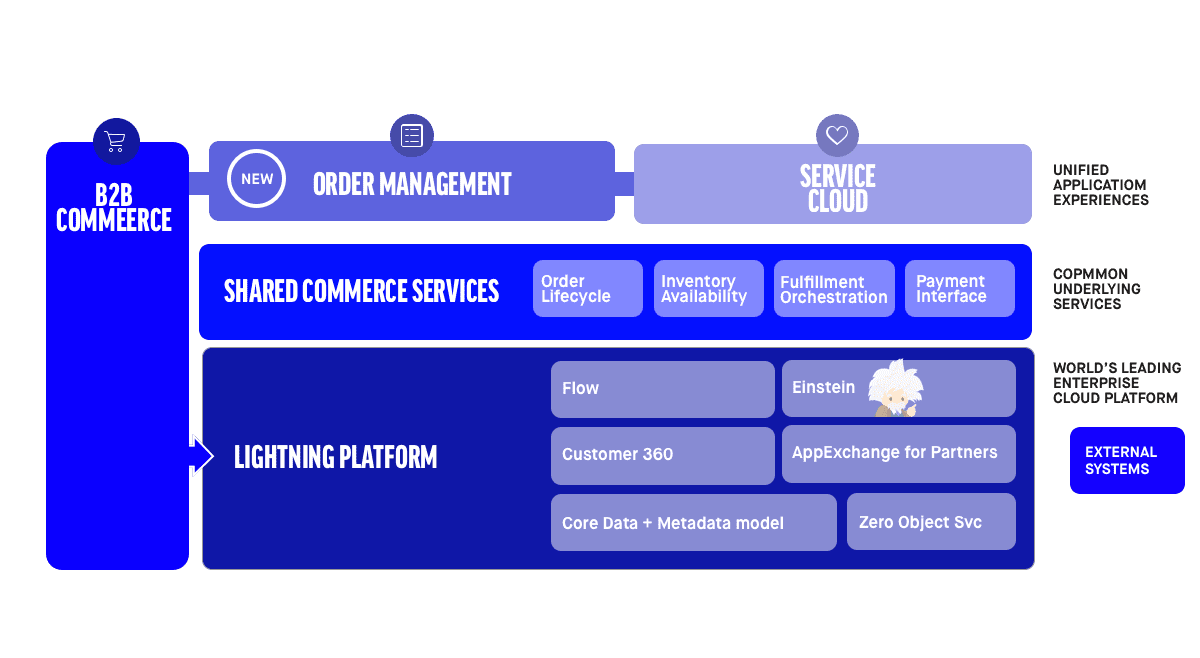You’re probably already familiar with Salesforce and know that it provides premium commerce experiences. It’s a platform built for growth and designed for innovation and connected to a peerless CRM (Customer Relationship Management).
At DEPT®, we’ve been using Salesforce to service our clients for years. After all, it encompasses both B2C and B2B commerce, the proprietary Einstein AI, the AppExchange ecosystem, the Trailblazer community, as well as Trailhead for Commerce.
Always on the lookout for new opportunities, after a successful pilot in May 2019, Salesforce went live with an order management system on February 18th of this year: SOM (Salesforce Order Management). Something we’d like to tell you all about.
Salesforce Order Management: it’s about time
Salesforce originated as a CRM, a method to manage your relationships with new and existing customers. In the last few years, they’ve steadily worked towards making e-commerce part of their wheelhouse as well. But e-commerce gets more complicated once your company gets bigger, goes international, or incorporates brick-and-mortar stores.
That’s where order management comes in: a way to ensure your customers’ orders are processed correctly, fulfilled in a timely manner, and that returns can be handled with flexibility and ease. Adding an order management system to their portfolio was only a matter of time, and it’s an addition that promises to save its users time as well as money.
An abundance of answers to a plethora of problems
E-commerce comes with a variety of challenges, many of which might seem daunting to tackle on your own. That’s where SOM comes in, which promises to assist you with a variety of features.
- Order lifecycle management: SOM provides an end-to-end supply chain workflow to manage order fulfilment, payment capture, invoice creation, and custom business logic.
- Connected commerce and service experience: With unified customer profiles and order history, you unlock seamless commerce, call centre, and self-service scenarios.
- Built on the Lightning platform: SOM is powered by Salesforce Lightning for easy extensibility, modern micro-services, and custom visual workflows.
- Partner ecosystem: And to make things even easier, it features pre-built connector apps for supply chain partners including: payments, tax, fraud, WMS, and shipping via AppExchange.
Delving deeper into the Salesforce ecosystem
What SOM can do should be somewhat clear by now, but how does it function exactly within the context of the Salesforce ecosystem? A question that’s most easily answered in an infographic:

Greater than the SOM of its parts
Thus far, we’ve covered the bigger picture of SOM. But what matters most to you is, of course, which capabilities SOM features, for you to lift your business to a higher level. Succinctly put:
Order lifecycle
- Enjoy full visibility into order status from creation through fulfilment
- Seamlessly integrate with B2C commerce orders
- Integrate orders from additional channels (such as marketplaces, POS)
Basic order fulfilment
- Orchestrate the fulfilment process for a small set of distribution centres
- Configure your fulfilment workflow via Lightning flow or Apex
- Integrate with fulfilment providers (such as WMS, ERP)
- Process payments and invoices
Payment capture & refund
- Accept both credit card and electronic payment methods
- Generate and integrate invoices with ERP
- And, coming soon: support for Adyen & gift cards (July 2020)
Order servicing
- View order history
- Process order cancellations
- Process order returns
- And, coming soon: appeasement (July 2020)
Reporting
- Make use of order, fulfilment, payment, and returns reporting
What does the SOM roadmap look like?
As mentioned in the previous section, some SOM functionalities are not supported as of yet but will be soon. SOM promises to be a solution to several e-commerce conundrums, so rolling out its many features will take a little while.
Some things to look forward to are the distributed order management (DOM) beta in October 2020, omnichannel inventory and an even higher scale in February 2021. After that, we’ll be seeing B2B2C capabilities, subscriptions, digital goods and scheduled services.
Which is not to say that you have to be patient to enjoy what SOM has to offer. Its tools are already massive time-savers, boasting versatility and flexibility. Interested in incorporating SOM in your organization? We can help you with that, thanks to our extensive experience with order management for companies such as Tiger of Sweden, Bonmarché, Magasin Du Nord and so on.
In addition to that, as one of a select few parties that has gone through the SOM enablement process, we can really help you harness SOM: organising, managing, and supporting your business through our official partnership with Salesforce. So even things that might not be possible out-of-the-box straight away, we can help you realise through custom flows.
Curious what DEPT® and SOM could do for your business? Don’t hesitate to contact us.
More Insights?
View all InsightsQuestions?
VP eCommerce Europe





